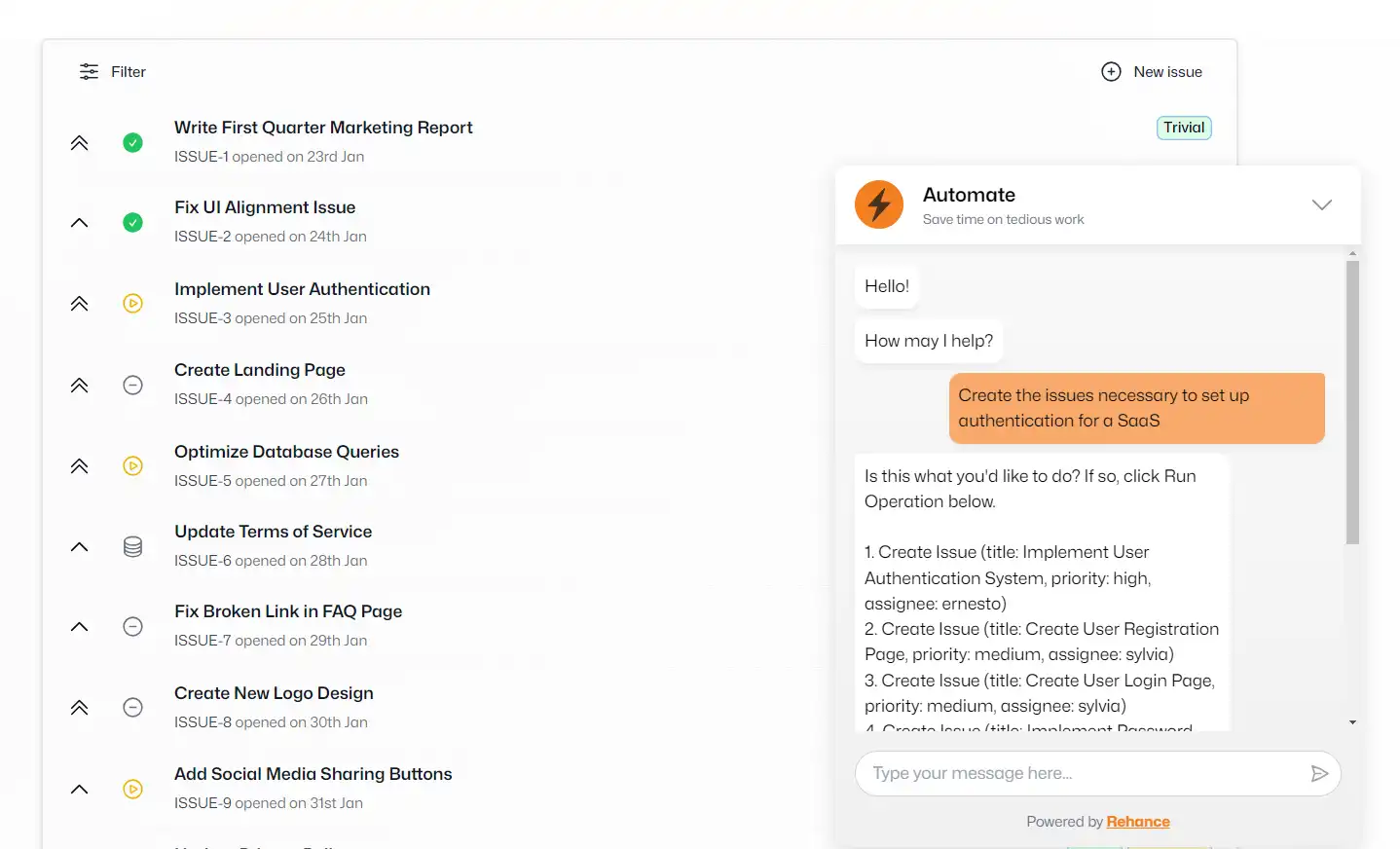Chatbots Kinda Suck, Don't They?
Chatbots have become ubiquitous in the Software as a Service (SaaS) industry, aiming to provide quick and automated customer service. But many of these chatbots fail to meet user expectations, leading to frustration and inefficiency. In contrast, Rehance's output-oriented chat interfaces present a new approach, offering a more efficient and precise way to handle user requests. This article explores the limitations of traditional SaaS chatbots and the advantages of adopting an output-oriented chat interface instead of a conversational or engagement-oriented one.
Key Takeaways
- Traditional SaaS chatbots often fall short due to their inability to actually get things done for the user.
- Output-oriented chat interfaces, like those developed by Rehance, enable users to execute actions directly via text, bypassing the need for complex dialogue and minimizing misunderstandings.
- The future of chatbots is likely to see further integration of advanced natural language processing and AI, making it even easier to map user requests to task completion.
The Pitfalls of Traditional SaaS Chatbots
No Ability to Get Things Done
We've all experienced the frustration of interacting with a chatbot that can't actually do anything. These chatbots are often programmed to either provide generic responses or redirect users to a tutorial or human customer support agent. This approach is not only inefficient but also ineffective, as it fails to address the user's key need: getting things done.
Remember, a chatbot that can't get things done is a time-waster for users, leading to frustration and churn.
Unnecessary Conversation
Despite the name "chatbot", users are really not looking to chat. They want to get things done as quickly and efficiently as possible, and they're turning to the chatbot because they believe it can help them do that. Unfortunately, many chatbots are programmed to engage in unnecessary dialogue, mimicking human interaction, and wasting the user's time.
Users don't want small talk with chatbots, they want to get things done fast!
The Rise of Output-Oriented Interfaces
What Are Output-Oriented Interfaces?
At the heart of our discussion are output-oriented interfaces, a paradigm shift in how we interact with software through text. Unlike traditional chatbots that attempt to mimic human conversation, output-oriented interfaces are all about routing the user request to the expected operation output as quickly as possible. Every interaction is about mapping the user's intent to specific operations in the SaaS they're using, not engaging in useless conversation.
Output-oriented chat interfaces are best in software that supports a wide range of operations. Some verticals that benefit most from this approach include:
- Productivity software, like project management tools and CRMs, where users need to store and organize large amounts of documents and data.
- Creative software, like website builders, graphic design, and video editing tools, where users need to create and edit complex content and figure out hundreds of complex tools.
- Financial software, like accounting and tax software, where users need to manage their finances and analyze reports.
Embrace output-oriented chat interfaces to give your users what they're looking for — results — and not conversation.
Efficiency in Execution: The Rehance Approach
Streamlining Interactions with Precision
At Rehance, we've honed the art of getting things done for users using just their plaintext input. Our output-oriented design interprets every message as a request to do something in the software, searching through the supported operations and mapping it to the most relevant one (or more). And we do this with a high degree of accuracy, since our clients can define the exact operations supported by their software and the parameters they expect.
- Direct Action: Users can perform actions directly with text, bypassing the need for navigating complex menus or filling out forms.
- Clear Feedback: Rehance's proposed list of operations in response to a user request is always presented to the user for approval before execution.
- Contextual Understanding: Our clients pass along the user request along with contextual data to help Rehance understand the user's intent and pass the correct parameters to the resultant operations.
Rehance's output-oriented design interprets every message as a request to do something in the software, searching through the supported operations and mapping it to the most relevant one (or more).

Integrating Rehance into Your SaaS Ecosystem
Technical Considerations
We've made it as easy as possible to integrate Rehance into your SaaS ecosystem. Here are the key steps:
- Define supported operations: Rehance needs to know what actions your software supports, and what parameters they expect. This can be done in our dashboard after creating an account.
- Define relevant context: Rehance needs to know what contextual data is relevant to your users. Define the shape of this context in our dashboard, and pass it along with the user request.
- Integrate: You can integrate Rehance with a drop-in JS script that can get the chat-based UI up and running in minutes. If you prefer, you can instead use our API endpoint and build your own UI.
Conclusion: The Path to Superior Chat-Like Experiences
In the realm of SaaS chatbots, the journey towards excellence is paved with the recognition that efficiency is key. Traditional chatbots often fall short, bogged down by attempts to mimic human conversation without delivering on the promise of speed and precision. Rehance's output-oriented chat interfaces represent a paradigm shift, offering a streamlined approach that respects the user's time and intent. By mapping every request to a set of tasks that your SaaS can execute, Rehance not only sidesteps the pitfalls of its predecessors but also sets a new standard for what chatbots can achieve. As businesses continue to seek out tools that empower their users, it's clear that the output-oriented chatbot model is not just an alternative, but the future of chatbot technology.
Frequently Asked Questions
What are the main issues with traditional SaaS chatbots?
Traditional SaaS chatbots often fail to meet user expectations due to their inability to actually get things done for the user. They also waste time with unnecessary conversation, leading to frustration and inefficiency.
How do output-oriented chat interfaces improve upon traditional chatbots?
Output-oriented chat interfaces allow for more precise and efficient interactions by mapping user requests to specific operations in the SaaS ecosystem. This approach reduces the need for complex dialogue and minimizes misunderstandings.
What is Rehance, and how does it differ from other chatbot solutions?
Rehance is a platform that specializes in output-oriented chat interfaces for SaaS applications. It streamlines user interactions by mapping every request to a set of tasks that the SaaS can execute.
What are some technical considerations when integrating Rehance into a SaaS ecosystem?
To integrate Rehance into a SaaS ecosystem, you'll need to define the supported operations and relevant context in our dashboard. You can then integrate Rehance using our drop-in JS script or API endpoint.
